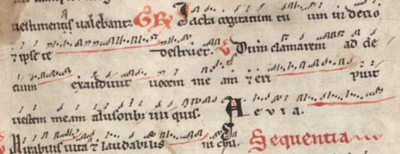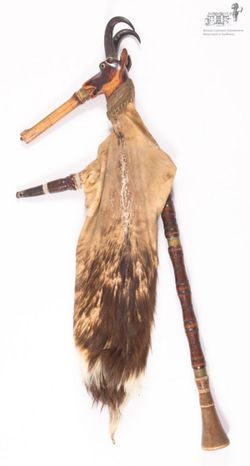Template:DRM images: Difference between revisions
| Line 47: | Line 47: | ||
Watermark examination provides a fundamental (analogue) method of sorting and ordering materials that are undated or lack a provenance. They are especially useful for clustering manuscripts by paper type. The combination of digital photography and tools for photographic editing can be combined with extensive existing research on paper-makers to shed new light on musical sources. The sites listed here include watermarks associated specifically with music manuscripts. | Watermark examination provides a fundamental (analogue) method of sorting and ordering materials that are undated or lack a provenance. They are especially useful for clustering manuscripts by paper type. The combination of digital photography and tools for photographic editing can be combined with extensive existing research on paper-makers to shed new light on musical sources. The sites listed here include watermarks associated specifically with music manuscripts. | ||
====WILC: Watermarks in Incuabula printed in the Low Countries==== | |||
Website: [http://watermark.kb.nl/page Watermarks in Incuabula printed in the Low Countries (WILC] | |||
Many early printing presses operated in the Low Countries. This database lists more than 2,000 of them. It contains large numbers of beta radiographs from incunabla and forms part of the Bernstein project listed separately. | |||
====WZIS: Watermark Information System==== | ====WZIS: Watermark Information System==== | ||
Revision as of 22:29, 25 September 2015
Digital Scriptorium
Website:Digital Scriptorium
Image database of medieval and renaissance manuscripts. Based at the University of California, Berkeley, it includes holdings from many US libraries, with extensive folio-specific information about each source.
Index of Christian Art
Website: Index of Christian Art
One hundred twenty thousand (120,000) images from public and private collections in the English-speaking world plus additional indices; roughly 100,000 are available to the public via fee-based institutional subscriptions. Holdings from early centuries of Christianity to 1550.
Manuscriptorium
Website: Manuscriptorium
The National Library of the Czech Republic started this site to make available digital images of historical materials in its own collections and those of collaborators. its emphasis is on manuscripts, early prints, incubulae, and the like. In addition it is building research tools to support such endeavors. Manuscriptorium constitutes a subcategory of Europeana. Many of its holdings are conveyed in obsolete scripts, for which the site offers a useful character-identification lexicon called Gaiji. Its obviously later sheet-music collection has also been popular.
Medieval Legends with Music
The Carmina Burana
Website: The Carmina Burana

The 11th- to 12th-century collection of poetry and dramatic texts is rich in illustration and many of its texts contain cheironomic notation. Although found in a Benedictine abbey in Bavaria in 1803 and housed today in the Bavarian State Library, its origins point to compilation along the southern fringe of Austria, particularly Carinthia. Its Goliard sources come from Spain, the British Isles, France, and elsewhere in Europe. The texts are predominantly in medieval Latin, with some examples of Middle High German and Provençal. Musical settings of individual pieces are numerous following Carl Orff's 1936 presentation of 24 of the pieces (roughly one-tenth of the collection).
Songs of the Nibelungen
Website: Das Nibelungenlied
These poetic texts, considered to date from before 1280, display settings of the legends that inspired Richard Wagner. As is characteristic of those resources preserved for posterity in this period, the script is very carefully prepared, the vellum on which it is preserved obviously sturdy. Each Lied is illuminated by a carmine letter. The texts mention Sifriden (Siegfried), Prvnhilde (Brunhilde), Gvnther (Gunther), and others. The illustration shows the first three stanzas of "Wie Gvnther Sifriden zvo der hohzit bat" (No. 12 of 39). Later portions of the source contain religious songs (Klage).
Polish Folk Instruments
Website: Polish Folk Instruments

The Museum of Folk Instruments in Szydłowiec, established in 1968, houses the largest collection of folk instruments in Poland and documents rich musical relationships with adjacent regions. Holdings date from the seventeenth century onward and currently number more than 2,000. The collection (which is housed in the Szydłowiecy-Radziwill Castle, is particularly rich in bowed instruments, cymbals, and bagpipes.
Watermark Databases
Watermark examination provides a fundamental (analogue) method of sorting and ordering materials that are undated or lack a provenance. They are especially useful for clustering manuscripts by paper type. The combination of digital photography and tools for photographic editing can be combined with extensive existing research on paper-makers to shed new light on musical sources. The sites listed here include watermarks associated specifically with music manuscripts.
WILC: Watermarks in Incuabula printed in the Low Countries
Website: Watermarks in Incuabula printed in the Low Countries (WILC
Many early printing presses operated in the Low Countries. This database lists more than 2,000 of them. It contains large numbers of beta radiographs from incunabla and forms part of the Bernstein project listed separately.
WZIS: Watermark Information System
Website: Wasserzeichen Informationssystem Deutschland

The WZIS is a project of extensive scope. Its goal is to compile a graphical database of watermarks used throughout Europe. The project is based at the Landesarchiv of Baden-Württemberg. A graphical watermark lexicon called Piccard is under development at the Stuttgart Hauptstaatsarchiv. Related lexicons of makers and mills have also been developed. A textual search form is also available. Although we are aware of many other digital collections of watermarks, this one stands out for its tight coupling with music manuscripts, particularly in the large collections of the Berlin and Dresden state libraries, which are in turn linked to the RISM OPAC.